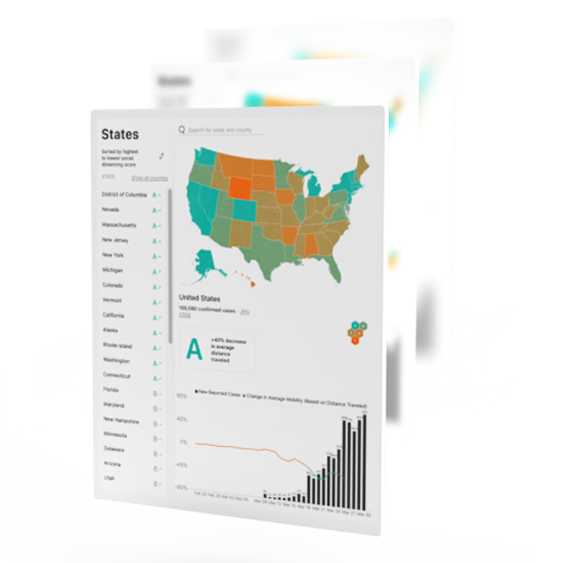eBook
Retail Site Selection
The importance of site selection in new markets
Companies are increasingly relying on analytics provided by aggregate data sets to measure new business location viability in rapidly changing times.
Unacast has partnered with Precisely to offer comprehensive, business-enhancing solutions for multinational retailers looking to expand to a new site. Driven by decades of experience and utilizing the latest aggregate and data cluster technologies, Unacast and Precisely together offer insight into foot traffic and migration patterns, and can map customer profiles and data to optimize success in a new location.
Our combined data is engineered to match the specific needs of a retailer, leveraging advanced knowledge of countries, regions, and even towns and intersections of a proposed retail site for optimized site selection.


Choosing the right location matters
One of the most important factors in the success of a new retail location is a customer’s ability to find it on a map. Location data services provide valuable insights into the optimal areas a retailer
could open a business.
Enterprise intelligence (IQ) is the ability to make smarter and easier decisions. A retailer moving into a new market is better served understanding the reality of their next location from a variety of data points. It’s important to forecast consumer trends by season, look at foot traffic increases on weekends, and observe the human migration
patterns of residents in the surrounding community.
Consumers have become increasingly time-poor and value oriented. Ensuring a retail site selection maximizes visibility in a heavily-trafficked and demographically appealing area is key when expanding your business in the reality of a rapidly-evolving market.
The science of site selection
The relevant data for site selection is based on core elements. A shift from personal device data collection to aggregate data, or cluster data, provides insight into people’s geography-specific migration patterns.
Historical location data collection focused on single personal devices at rest within narrow time frames and geopoints. Consideration of privacy and utility shifted data scientists to aggregation methods, or clustered data, where geography-specific insights could be gleaned from privacy-enhanced procedures.
This shift improved implementation of dynamic data extrapolation where devices at rest in a physical location over a limited period of time could be charted across time and space to create dynamic clustered data sets.
Limitations in capturing only stable and predictable activity, i.e. a device left charging overnight in someone’s home, has now expanded to include active rituals like mid-afternoon coffee runs and nighttime dinner plans. Aggregation allows for large-scale insights over millions of individuals, unlocking important real-world knowledge of human behavior without exposing the routines of single individuals.
Location Intelligence and Analytics at Precisely highlights the movement from static to dynamic data as being a key innovation for retail site selection.
Kenny Ling, Senior Project Manager, Unacast
The aggregate data phenomenon
Consumer privacy is a premium in today’s world. Continued focus on single devices provides insignificant insights when contrasted with the power of aggregation across millions of devices.
What was once thought of as a limitation has now become a data-rich tool in the process of analyzing consumer data.
By pooling multiple data sets, a business’s growth potential can be estimated in light of local real estate development, demographic insights and the median income of the surrounding community.
The big shift
The COVID-19 pandemic is an event with long-term implications. While some have benefitted, many retailers have fallen by the wayside due to seismic shifts in consumer patterns.
Lease investments might be a source of regret for businesses when a site can’t accommodate shifting needs. When restaurants were forced to close or downscale their dining areas, the viability of curbside pickup, drive-thru lanes and third-party delivery options were important pivots.
By measuring the number of devices in a specific region weekly, a momentary snapshot of the foot traffic in a target destination is possible.
This valuable location data can pinpoint hotspots and peak traffic times. It also allows insight into whether or not altering a physical location is a better option than seeking out a new one.


Where are people going?
The pandemic also changed human migration patterns, not only increasing remote work but instigating relocation on a massive scale. Insight into emerging urban centers is essential.
Beyond data aggregation at the street level, we also observe devices over a period of eight weeks to assign accurate home locations and reflect residence changes. This important diagnostic information is aggregated and integrated with real estate data to determine where consumers reside and evaluate shifting demographics.
Risk management, network optimization, and targeted marketing strategies can be implemented prior to site selection.
Trusted, reliable location reduces the worry associated with choosing the perfect spot.
A leg up
In ascertaining the foot traffic potential of a particular location, a savvy business also considers the presence of competitors. The more desirable the real estate, the more likely a similar market-serving business will open or has already opened in the vicinity.
Data enrichment solutions can append and enhance existing collected information to deliver unprecedented insight into not only the competition but the location of the retail business as well.
Everything from the buying patterns of the desired audience to the demographics of the surrounding community can inform an impending real estate transaction.
By determining which sites are near frequently-trafficked areas, a retailer can zero in on hotspots in order to ensure a successful move.


Insight, anywhere
In our globally connected age, site selection isn’t a local matter. A retail business that would be considered risky in the Netherlands may be a hit in Australia.
Taking advantage of big-box grocery stores’ inability to keep up with online orders during the pandemic, Sydney startup Milkrun helped turned the promise of ‘instant delivery’ into a sector unto itself.¹
Securing a $75 million investment to expand across the country, the success of Milkrun and other operators in the newly-minted rapid delivery business space showcases the value of forecasting consumer needs.
The rise of Enterprise IQ has traditionally coincided with retailer maturity. Aggregated data sets allow new and established companies alike to enjoy insights into the buying patterns of their target consumer.
¹https://www.businessinsider.com.au/instant-delivery-service-milkrun-75-million-raise-expansion
Open shop
Site-specific data is available to ensure a retail location opens in the optimal physical space. Does a new business require a street front, or the end unit of a retail plaza in order to accommodate a drive-thru?
The Unacast Visitation Activity data set collects confirmed visit information related to known points of interest (POIs). By collecting timestamps and the average longitude and latitude of combined visits to the venue, a new business enters the marketplace with the knowledge of where foot traffic is coming from, and what businesses, attractions and venues serve the similar interests of their targeted consumer base.
Implementing a core methodology affords a business valuable insights into the presence of competitors, sister stores, channels and eCommerce solutions.


Aggregated data solutions tailored by Precisely to your business needs
Your company deserves a one-stop shop for the data relevant to driving your business. With Unacast and Precisely, the guesswork traditionally associated with retail site selection can be eliminated.
The collaboration between Unacast and Precisely seamlessly integrates refined data collection and deep domain expertise to ensure direct line-of-sight and interactivity.
Interested in learning more about location analysis, traffic counts and how aggregated data can impact your next retail site selection? Join companies in Australia, Netherlands, the United Kingdom, and Germany in partnering with Unacast and Precisely’s Dynamic Demographics solution.
